Acoustic Instrument
Primers
What Kind of Guitar
Should I Start On?
What Kind of Banjo
Do I Want?
Evaluating and
Buying Used
Guitars
Setting Up
Fretted Instruments Whatever Happened
to the Banjo?
Beginning Five-
String Banjo
6-String Banjos
Banjo Pickups
Axes in my Life
What is a
Bluegrass Banjo?
Dean "Backwoods
Six" Shootout
Music Theory
Primers
Introduction
to Scales
Introduction
to Chords
Circle of Fifths
Other Articles
About Music
How to Give
Guitar Lessons
Musician or
Wannabe? Did God Really
Give Rock &
Roll to You?
Are You a
"Brand Bigot"?
Who Owns Folk Songs?
Historical Links
About the
National Road
The Story Behind
the Story - Real
People, Places,
and Events
About the Play
Play Home
What's New
Overview
About the
Music
About the
History
About the
Logistics
About the
Cast
Synopsis
About the
Set
About the
Author
Contact Us
Home

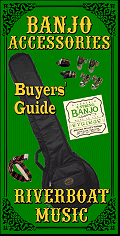

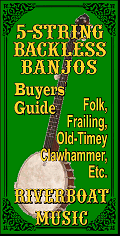

|

|
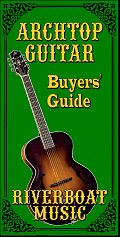
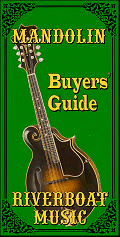
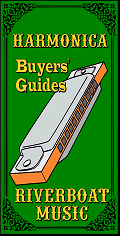
Beginning Five-String Folk Banjo - Part Thirteen - Arpeggios and Celtic Styles
| Written by Paul Race for Creek Don't RiseTM and School Of The RockTM |
Sometimes the bum-ditty patterns we've been using all along seem a little too "bouncy" for certain kinds of music. Another kind of roll that is used in all kinds of 5-string playing is the arpeggio. In this pattern, you play a chord one note at a time.
Some folks who are afraid to use their ring finger to pluck strings have figured alternative means of playing this that include the thumb picking string 4, 3, or 2 as well as 5. This is called "double-thumbing" and is used in several frailing rolls as well.
To me it's not as important which fingers you use to pluck which strings on your arpeggios as it is to have a smooth consistent rhythm.
That said, most traditional Irish banjo players before about 1950 used flatpicks to play individual notes - especially the melody. They also almost all played four-string banjos tuned one octave down from the mandolin. In the 1950s, Irish banjo players were influenced by Skiffle and Folk Revival music to begin gradually adding more chord-based accompaniments to their repertoire. As often as not those chords were not strummed, but flatpicked a note at a time in arpeggios. Some in the next generation did start learning US-style 5-string banjo, and some also started using fingerpicking instead of flatpicks to play those arpeggios. So an Irish-inspired band you see today won't necessarily stick to one kind of banjo or one way to play, but the old Irish flatpickers still have influence.
The band Mumford and Sons is not Irish, which is why we've broadened our terminology to "Celtic." But their banjo player typically uses Irish-style fingerpicked arpeggios. Bands influenced by M&S (including "Stomp" bands) tend to use the banjo to play arpeggios as well. At this time, more seem to fingerpick than flatpick.
The good news is that any 5-string banjo player with good dexterity can pick this up in a few minutes.
The bad news is that this doesn't make you, technically an "Irish banjo player," unless you can also flatpick about a thousand fiddle tunes from memory, preferably on a four-string banjo tuned an octave down from mandolin (EADG). If you can't do that, please don't feel bad - I can't either, and neither can some of the pickers in Stomp bands today.
In fact, if you want to practice the song with just the G chord until you're comfortable with the right-hand pattern, nobody familiar with the tune will be upset about it. Some arrangements are more ambitious chordwise. For example in the version below, you could also go to D7 on measures 5 and 13, but we chose the more traditional harmonization and stayed on the tonic on those measures.
Where's the Wagon? - In case you wondered, this song has at least a dozen verses - much more if you compiled all the various versions together - and only one or two directly mention the "waggoner's son." In one version the narrator confesses that she has an impolitic love for the "waggoner's son," presumably a boy with no education and few prospects. Another verse seems to be from his perspective - it includes the lines "My horses ain't hungry; They won't eat your hay," which connotes a rejection of her affections.
 I showed a version of this all the way back in Lesson 2. If you look at the little letters below the tab, you'll see that I'm bringing my ring finger of my right hand into play.
I showed a version of this all the way back in Lesson 2. If you look at the little letters below the tab, you'll see that I'm bringing my ring finger of my right hand into play.  If you have the coordination to do this (Index, Middle, Ring, Thumb) again and again, you can get going very fast. Almost as fast as the Celtic-inspired banjo players you're hearing on music from Mumford and Sons and a dozen bands they've inspired. That said, an arpeggio is also useful for slow songs that don't need a pulsing strum.
If you have the coordination to do this (Index, Middle, Ring, Thumb) again and again, you can get going very fast. Almost as fast as the Celtic-inspired banjo players you're hearing on music from Mumford and Sons and a dozen bands they've inspired. That said, an arpeggio is also useful for slow songs that don't need a pulsing strum.
A Note about Irish (Celtic) Banjo Arpeggios
Why am I bringing the Irish into this discussion? Because lightning-fast banjo arpeggios have become a hallmark of certain contemporary Celtic-inspired musical movements, including "Stomp Band" music.
3/4 Example: "The Wagoner's Lad"
Here's a song that goes way back into the folk idiom, before modern chord progressions had "settled in." So it seems to end on the wrong note and chord. It's also a pentatonic song, meaning that the melody has only five notes (1, 2, 3, 5, 6 of the modern major scale). Many tunes in this class came directly from Ireland or Scotland two or three centuries ago. In some ways, they seem harmonically static - the melodies don't usually imply very many chord changes. In fact, this song has been "harmonized" just by playing the tonic and fifth note on drone strings (such as Appalachian dulcimer) all the way through. (In this key that would be G and D.)

4/4 Example: "Whiskey In the Jar"
For my 4/4 example, I've chosen a traditional Irish song that is usually played about the same tempo as most "stomp bands'" "fast songs." That said, I've never heard this particular song accompanied this way - this is just to get you used to the type of arpeggio patterns being used in Celtic-inspired music today.To hear this banjo part, click this icon: 

What about Solos? - Yes, you've gotten used to me adding a solo part after the accompaniment part I provide. However, on most songs, it's pretty hard to solo and play arpeggios at the same time. If you really want to try a solo version of "Whiskey in the Jar," click here to see the pdf of one. It tends to use our more traditional "bump-ditty" roll, but you can go in and out of this and the accompaniment part above seemlessly if you want to take an instrumental break during a vocal performance of this song.
To hear the solo version we have transcribed, click this icon: 
Conclusion
The arpeggios you've learned in this lesson aren't just for Celtic-inspired music, of course; they can be used for many different kinds of songs. Practice some of the other songs we've already done this way - "Boil That Cabbage Down," as always, is a great candidate.In addition, there are several different kinds of picking patterns that you can try out at the Elfshot Banjo Rolls page.
If you've been communicating with other banjo players all along, you may have been resisting their pleas to do things the only "right," or "authentic" way, by which they mean the way they do it. I haven't insisted on that, since I think you deserved a chance to learn the basics before pigeon-holing youself into one specific subculture or another. That said, if you've decided that three-finger picking, or clawhammer, or any particular style is right for you at this junction, there's no reason not to find a teacher or text that will take you further down that path. But don't feel you have to do everything the way it was done fifty years ago. Music develops because people try new things.
At the moment we have only one more lesson planned - on modal songs that you're likely to come across if you dig deep into "old-timey" mountain music. Like minor key songs, they're apt to "break the mold" on chord progressions, and many of the songs and harmonizations have to be taken "on faith" as it were. But exposing you to a few of the odd things you're likely to encounter on modal songs should help you be prepared.
In the meantime please contact us if you have any questions or hit any brick walls.
All material, illustrations, and content of this web site is copyrighted © 2001, 2002, 2003, 2004, 2005, 2006,
2007, 2008, 2009, 2010, 2011, 2012, 2013, 2014, 2015 by Paul D. Race. All rights reserved.
Creek Dont' Rise(tm) is a participant in the Amazon Services LLC Associates Program, an affiliate advertising
program designed to provide a means for sites to earn advertising fees by advertising and linking to Amazon.com.
For questions, comments, suggestions, trouble reports, etc. about this play or about this web page, please contact us.
| Visit related pages and affiliated sites: | ||||||
| - Music - | ||||||

|
 |
 |

|

|

|
|

|

|

|

|

|

|
|
| - Trains and Hobbies - | ||||||
 |

|

|  |
 |

|
|
| - Christmas Memories and Collectibles - | ||||||
 |

|
 |

|
 |

|
|
| - Family Activities and Crafts - | ||||||
 |

|

|

|

|

|
|
